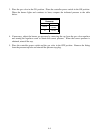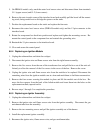
6-1
Inside the Ignition Module
TD
Out to
Gas Valve
To Alarm
25 V +
25 V GND
HV
Ignition Wire Flame Sensor
Coil
FBR18 & FBRA18 SERIES GAS RETHERMALIZERS
CHAPTER 6: SERVICE PROCEDURES
6.1 Functional Description
These rethermalizers contain a welded stainless steel cookpot that is directly heated by a high effi-
ciency burner system requiring approximately 43% less energy than conventional burner systems to
heat the same volume of water.
Two self-contained combustion chambers (referred to as “burners”) are located beneath the cookpot.
Each combustion chamber is fitted with special ceramic tiles that are heated by the burning of a
forced air/gas mixture. The tiles transfer their heat to the cookpot by means of infrared radiation,
providing much more constant and uniform heat dispersion over the surface of the cookpot than do
conventional burners. Because relatively less heat is lost to the atmosphere in the process, compared
to “open-burner” designs, less fuel is required to achieve and maintain a given cookpot temperature.
Gas flow to both of the burners is regulated by one electromechanical gas valve.
THE ELECTRONIC IGNITION SYSTEM
Ignition modules, located in the component box, are
connected to ignitor assemblies at each burner. An
ignition module performs four important functions: it
provides fuse protection for the 24-volt circuit, provides
an ignition spark, supplies voltage to the gas valve, and
proofs the burner flame. The module contains a 4-
second time delay circuit and a coil that activates the
gas valve.
The ignitor assembly consists of a spark plug, an
enrichment tube, and a flame sensor.
At start-up, the power switch is placed in the ON
position, supplying approximately 12-volts DC to the
heat control circuitry in the controller and to one side of
the heat relay coil on the interface board. If resistance
in the temperature probe indicates the temperature in the cookpot is below 160ºF (71ºC), the current
flows through a warm-up circuit containing a timer switch that alternately closes for 4 seconds and
opens for 24 seconds. If the temperature is 160ºF (71ºC) or above, the current flows through a heat
circuit, bypassing the timer switch. In either case, ground is supplied to the other leg of the heat re-
lay coil, which then closes an electronic switch in the 24 VAC circuit to provide current to the igni-
tion module.
Circuitry in the ignition module sends 24 VAC to the gas valve. Simultaneously, the module causes
the ignitor to spark for 4 seconds to light the burner. A flame sensor verifies that the burner is lit by
measuring the flow of microamps through the flame. If the burner does not light (or is extin-


















